Defence minister Rajnath Singh on Thursday said a broad consensus had been achieved by India and China on restoring the “ground situation” in eastern Ladakh along the Line of Actual Control (LAC), including for patrolling and grazing cattle.
Speaking at the Chanakya Defence Dialogue organised by the Indian Army in Delhi, Rajnath said: “India and China have been involved in talks both at military and diplomatic levels to resolve differences in certain areas along the LAC. Pursuant to the talks, a broad consensus has been achieved to restore the ground situation based on the principle of equal and mutual security.”
He added: “The consensus achieved includes patrolling and grazing (cattle) in traditional areas. This is the power of engaging in continuous dialogue because sooner or later, solutions will emerge.”
The two countries have been locked in a border standoff since May 2020 following the Chinese army’s incursions at multiple points along the LAC in eastern Ladakh.
On Wednesday, Prime Minister Narendra Modi met Chinese President Xi Jinping on the sidelines of the Brics summit in Kazan, Russia. Both leaders were said to have endorsed the agreement on patrolling and disengagement along the LAC in eastern Ladakh and also issued directions to revive bilateral dialogue mechanisms, signalling attempts to normalise ties that were hit by a violent clash in the Galwan Valley in June 2020 in which 20 Indian soldiers were killed.
According to sources, the new agreement allows Indian forces to resume patrolling in key areas such as Depsang and Demchok which have been long-standing flashpoints in the standoff. A defence ministry official, however, said there was still not much clarity on the modalities of the agreement.
Indian Army chief General Upendra Dwivedi had on Tuesday flagged “trust” issues with China and said India wanted to restore trust and go back to the status quo of April 2020, a day after New Delhi announced that India and China had reached a patrolling arrangement along the LAC “leading to the disengagement” in eastern Ladakh.
“We want to go back to the status quo of April 2020. Thereafter, we will be looking at disengagement, de-escalation and normal management of the LAC…. This has been our stand since April 2020.”











